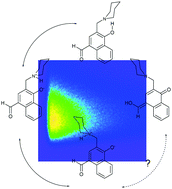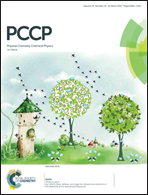Solvent control of intramolecular proton transfer: is 4-hydroxy-3-(piperidin-1-ylmethyl)-1-naphthaldehyde a proton crane?†
Abstract
The solvent dependent excited state dynamics of 4-hydroxy-3-(piperidin-1-ylmethyl)-1-naphthaldehyde (compound 2), a candidate for a molecular switch based on intramolecular proton transfer, was investigated by ultrafast spectroscopy and quantum-chemical calculations. In acetonitrile a mixture of molecules in the enol and zwitterionic proton transfer (PT) form exists in the ground state. However, the zwitterion is the energetically favored one in the electronically excited state. Optical excitation of the enol form results in intramolecular proton transfer and formation of the PT form within 1.4 ps. In addition we observe the appearance of a long living species with a rate of 1/(330 ps) which returns to the original ground state on time scales beyond 2 ns and which is attributed to the triplet state. In toluene the enol form is the only observed ground state tautomer, but no light induced proton transfer occurs. Again the long living triplet state is formed, even with a faster rate of 1/(11 ps). In methanol hydrogen bonds between 2 and solvent molecules stabilize strongly the PT form in the ground as well as in the excited state. Also in this case no light induced intramolecular proton transfer was observed but the formation of a long living species was. However, its absorption spectrum is distinctly different from the triplet state seen in acetonitrile and methanol.



 Please wait while we load your content...
Please wait while we load your content...